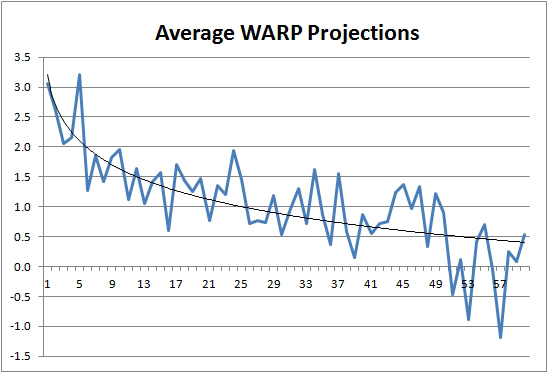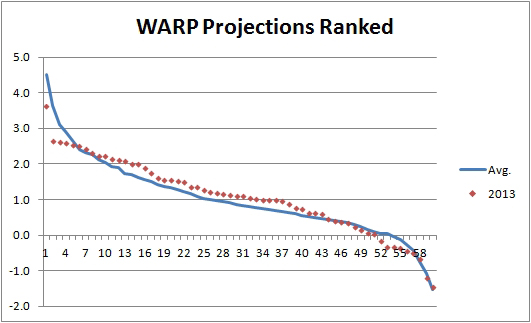By now, you've heard repeatedly about how weak the crop of prospects is for tonight's NBA draft. If the draft class were a player, the weaknesses section of its scouting report would be much longer than the strengths. Is that criticism justified? My WARP projections, published this week, offer an opportunity to objectively compare this year's group to recent drafts.
The "typical" draft
First, let's take a look at what the draft typically looks like in advance. Here are the average WARP projections for each pick from Nos. 1 to 60 over the past seven drafts (2006-12):

During such a short time period, the picks don't entirely average out. For example, the No. 5 pick has actually rated best of any spot because Kevin Love (2008) and DeMarcus Cousins (2010) were both the top-rated players in their respective drafts. That's no reason for the Cleveland Cavaliers to trade back to No. 5; it's just a fluke.
The best-fit line smooths out that variation and looks a lot like we'd expect. The differences between picks are largest at the top and become almost meaningless by the end of the second round. Graphing draft picks by the results they produce shows a similar trend.
The value of the best-fit line is it allows us to estimate the value of players, like Dennis Schroeder, Ricky Ledo and Giannis Antetokounmpo in this year's draft, without a statistical projection. That includes several past second-round draft picks and a handful of high-profile selections, including Enes Kanter.
Comparing to 2013
Because this year's draft has yet to take place, we can't compare the actual picks to past years' at the moment. But Chad Ford's top 60 serves as a reasonable proxy for how the draft will play out. Based on that, here's how the 2013 draft stacks up to its predecessors:
Draft Class Comparison
These numbers support the more nuanced assessment of this year's draft experts such as Ford have been trying to explain lately. The criticism of this year's draft is mostly about the top handful of picks. This year's top five would rate as the weakest in the past eight years, though 2006 (when Andrea Bargnani was the No. 1 pick) and 2010 (with low-rated Wesley Johnson and Evan Turner in the top five) score similarly.
Get outside that top group, however, and this draft looks fairly typical and perhaps even strong. If we limit our analysis to lottery picks, in fact, only 2010 scores better. That draft, which featured Greg Monroe at No. 7 and Paul George at No. 10, was a lot like this one in terms of depth -- except with an obvious top choice at No. 1 in John Wall.
A talent perspective
What if we go strictly based on the ratings? That offers a slightly different perspective. After all, part of the issue with the top of this year's draft is that the likely top five picks don't entirely match up with the players that project the best statistically.
Draft Class Comparison
Turns out that, even if the draft board went solely based on WARP projections, this year's class would still be short on elite talent. The strength of the 2013 draft from this perspective lies from the 15th-best prospect onward, where this group is as strong as any in recent memory. That's even more apparent when we graph this year's WARP projections against the average for the best player in the draft, second-best and so on.

As I noted Monday, Nerlens Noel is a little on the weak side for the top-rated prospect in a given draft class. The real issue, however, is that Noel is the only player with a WARP projection of 3.0 or better this year. Every draft from 2006-12 had at least two players with 3.0 projections or better, and 2009 actually had six. Once we get past the sixth-best prospect, the 2013 draft rates better than average all the way through the mid-40s.
The answer to the question of whether this is a bad draft depends a lot on where your team is picking. If you're in the top five, it certainly is weak, but this is a great year to be drafting in the teens or 20s. That's why we might not see a lot of pick-for-pick trades tonight. With so little difference between the top picks and late first-rounders, there isn't much incentive for teams to trade up.
